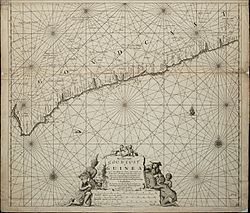Dutch Gold Coast
| Dutch possessions on the Coast of Guinea | ||||||||
| Nederlandse Bezittingen ter Kuste van Guinea (Dutch) | ||||||||
| Dutch colony | ||||||||
|
||||||||
|
||||||||
|
The Dutch Gold Coast around 1675.
|
||||||||
| Capital |
Fort Nassau (1598-1637) Fort Elmina (1637-1872) |
|||||||
| Languages | Dutch | |||||||
| Religion | Dutch Reformed | |||||||
| Political structure | Colony | |||||||
| Governor | ||||||||
| • | 1624–1638 | Adriaan Jacobs | ||||||
| • | 1656–1659 | Jan Valckenburgh | ||||||
| • | 1764–1767 | Jan Pieter Theodoor Huydecoper | ||||||
| • | 1816–1818 | Herman Willem Daendels | ||||||
| • | 1869–1871 | Cornelis Nagtglas | ||||||
| History | ||||||||
| • | Established | 1598 | ||||||
| • | Disestablished | 6 April 1872 | ||||||
|
||||||||
| Today part of |
|
|||||||
The Dutch Gold Coast or Dutch Guinea, officially Dutch possessions on the Coast of Guinea (Dutch: Nederlandse Bezittingen ter Kuste van Guinea) was a portion of contemporary Ghana that was gradually colonized by the Dutch, beginning in 1598. The colony became the most important Dutch colony in West Africa after Fort Elmina was captured from the Portuguese in 1637, but fell into disarray after the abolition of the slave trade in the early 19th century. On 6 April 1872, the Dutch Gold Coast was, in accordance with the Anglo-Dutch Treaties of 1870–71, ceremonially ceded to the United Kingdom.
The Portuguese were the first Europeans to arrive in contemporary Ghana. By 1471, they had reached the area that was to become known as the Gold Coast because it was an important source of gold. The Portuguese trading interests in gold, ivory and pepper so increased that in 1482 the Portuguese built their first permanent trading post on the western coast of present-day Ghana. This fortress, a trade castle called São Jorge da Mina, was constructed to protect Portuguese trade from European competitors.
The Portuguese position on the Gold Coast, known as Portuguese Gold Coast, remained secure for over a century. During that time, Lisbon sought to monopolize all trade in the region in royal hands, though appointed officials at São Jorge, and used force to prevent English, French and Dutch efforts to trade on the coast. After Barent Eriksz successfully sailed to the Gold Coast in 1591, Dutch merchants began trading in the area. Pieter de Marees's publications greatly increased the interest of merchants in the region.
...
Wikipedia



